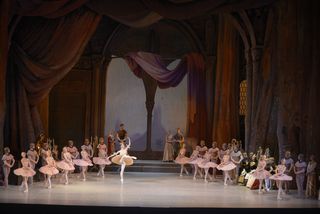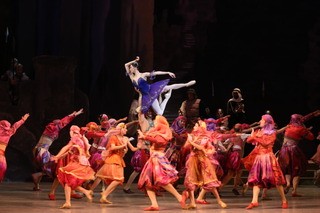|
Back
A Medieval Mixed-Bag Orange County
Segerstrom Hall
09/24/2015 - & September 25, 26, 27, 2015
Aleksandr Glazunov: Raymonda, Opus 57 (Choreography by Konstantin Sergeyev after Marius Petipa)
Viktoria Tereshkina*/Oxana Skorik/Anastasia Matvienko (Raymonda), Vladimir Shklyarov*/Andrey Ermakov/Timur Askerov (Jean de Brienne), Konstantin Zverev*/Yury Smekalov (Abderakhman), Renata Shakirova*/Nadezhda Batoeva (Henriette), Kristina Shapran*/Ekaterina Chebykina (Clémence), Filipp Stepin (Béranger), Andrey Soloviev (Bernard), Andrey Yakovlev (Seneschal), Elena Bazhenova (Countess Sybille), Soslan Kulaev (René de Brienne), Islom Baimuradov (Ali), Diana Smirnova/Ekaterina Ivannikova (Soloists: Act I), Alisa Petrenko/Oleg Demchenko (Saracen Dance, Act II), Anastasia Petushkova/Alexey Kuzmin (Spanish Dance-Panadéros, Act II), Ksenia Dubrovina/Dimitry Pukhachov (Mazurka, Act III), Olga Belik/Boris Zhurilov (Palotás, Act III), Nadezhda Batoeva (Variation, Act III), Anastasia Mikheikina/Svetlana Ivanova/Anna Lavrinenko/Svetlana Russkikh/Vasily Tkachenko/Filipp Stepin/Konstantin Ivkin/Alexy Nedviga (Grand pas classique honogrois, Act III), Viktoria Brileva/Diana Smirnova/Yuliana Chereschkevich, Elizaveta Antonova/Andrey Soloviev/Alexander Beloborodov/Roman Belyakov/Faud Mamedov (Grand pas classique honogrois, Act III), Konstantin Ivkin/Fuad Mamedov/Vasily Tkachenko/Alexey Popov (Male variation, Act III)
The Mariinsky Ballet and Orchestra, Valery Gergiev (Artistic and General Director), Gavriel Heine (Conductor)
Yury Fateev (Ballet Director), Simon Virsaladze (Scenic and Costume Designer)

(© Valentin Baranovsky)
Time has a way of preserving cherished masterpieces while opening doors to new possibilities. Change can be good yet change can befuddle. Marius Petipa’s masterful jeu de jambs have undoubtedly encouraged theatrical visions that can appear cohesive, controversial or confusing.
Segerstrom Center for the Arts opens its 30th season with the West Coast premiere of Raymonda by instituting the Konstantin Sergeyev “school of thought” with choreographic blips by Fyodor Lopukhov. For those traditionalists who cloyingly affirm Sergei Vikharev’s 1898 ‘reconstruction’ processes, as seen in the remarkable October 2011 La Scala production (Read here), Mariinsky Ballet’s current Ballet Director would ‘ruffle some feathers.’ Though not a glaring fan of 19th century period rejuvenation, Yury Fateev’s view retains classical respectability yet pops with dashes of progressivity. And while this form of thinking can make a compelling case for a shining Raymonda, other key ingredients must be on tap in order for Glazunov’s music to magically gel.
Gavriel Heine’s scoring is acceptably rich despite occasional irregularities that are ill-fitting for certain passages. In order to provide a fairytale ‘layered effect’, costuming and set design provide critical factors to the dancers. Set canvases, compliments of Simon Virsaladze, are two-dimensional and pedestrian although the two chandeliers in Act III add to the final festivities.

(© Natalia Razina)
Comprised of essentially three different casts spread across six performances, Krasnoyarsk-native Viktoria Tereshkina graces the stage in the title role. Ms. Tereshkina doesn’t necessarily ‘light the stage on fire’ in her opening “Entrée de Raymonde”, lacking expected youthful excitability. Even though Ms. Tereshkina subtly struggles with foot placement and half-hearted arabesques in the first two-thirds of Raymonda, she makes a demonstrative come-back in Act III during her “Grand adage”; the whirling white scarf, a trademark prop inside the “Un fantaisie” from Act I, is delicate and grounded.
Betrothed to Raymonda, Vladimir Shklyarov’s Jean de Brienne presents chivalric undertones, and grands jetés that are sharp and tight. With the limited amount of on-stage dancing, his conscientious charm, nonetheless, is endearing.
Some of the finest ballet dancing actually surfaces in the supporting roles: there’s a certain twinkling sharpness found inside Diana Smirnova’s “Dream variation #1” while Ekaterina Ivannikova’s “Dream variation #2” demonstrates coquettish sparkle. Similarly, troubadors Stepin and Soloviev are remarkably impeccable. With a reduced male contingency, there is one incredible execution inside the pas de quatre from the Grande pas classique hongrois with razor-like precision spins. Flawless.
But many puzzlements exist: where is The Apparition of the White Lady? The “Valse provençale” lacks male dancers. Where are all the children? Sprites and elves are wiped off the map during Glazunov’s tinkling “Ronde des follets et des farfadets.” Neither the “Rapsodie – Danse des enfants” nor the “Pas des mariscos” is to be found.
What can be said, however, is that this truncation paves way for choreography that mismatches the musical concept at the moment. Glazunov has so many diminutive bars tucked away in so many nooks and crannies that dramatically enable ethereal passages to glow. Mathematically, the music doesn’t mesh with choreography. Granted Act I is a bit choppy with spots of orchestral longeurs, it finds the audience staring aimlessly at a scrim full of corny cumulous clouds.
Elena Zaitseva’s costume revival is too monochromatic: one has difficulty discerning characters and the class levels within the castle of Doris (which is not even referenced in the synopsis.) Raymonda’s friends, Clémence and Henriette, are hard to distinguish, and they dance their individual “Variations” (Act II) with undervalued arching and pliability. The most colorful palette found rests inside Act III with its varying hues of browns and yellows alongside differentiating patterned textures. This helps elicit distinction and mollifies confusion. Both the “Mazurka” and “Palotás” exhibit clean diagonal lines and vibrant footwork akin to original Petipa requisites. An aside, the “Apothéose” is ductile.
Considered the “last grand ballet” of the 19th century, Raymonda is a specified gem with the potential to thrill at every turn of the page inside Glazunov’s music. Though more confusing under Valery Gergiev’s directive, other interpretations will be more lasting.
Christie Grimstad
|